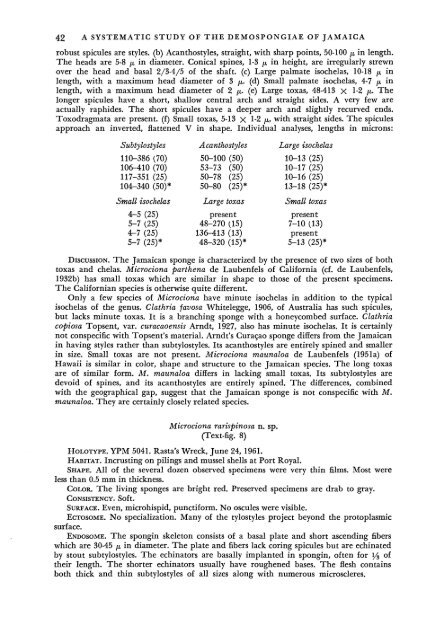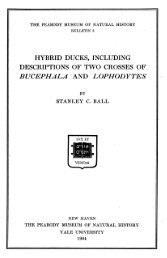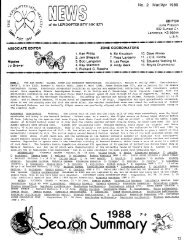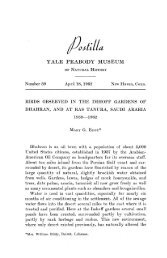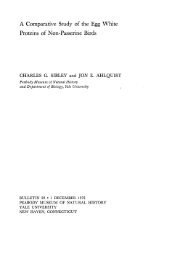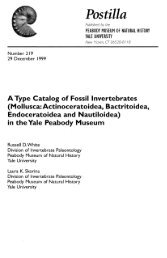Bulletin 20 - Peabody Museum of Natural History - Yale University
Bulletin 20 - Peabody Museum of Natural History - Yale University
Bulletin 20 - Peabody Museum of Natural History - Yale University
You also want an ePaper? Increase the reach of your titles
YUMPU automatically turns print PDFs into web optimized ePapers that Google loves.
42 A SYSTEMATIC STUDY OF THE DEMOSPONGIAE OF JAMAICA<br />
robust spicules are styles, (b) Acanthostyles, straight, with sharp points, 50-100 ^ in length.<br />
The heads are 5-8 /x in diameter. Conical spines, 1-3 LL in height, are irregularly strewn<br />
over the head and basal 2/3-4/5 <strong>of</strong> the shaft, (c) Large palmate isochelas, 10-18 LL in<br />
length, with a maximum head diameter <strong>of</strong> 3 LI. (d) Small palmate isochelas, 4-7 LL in<br />
length, with a maximum head diameter <strong>of</strong> 2 ju,. (e) Large toxas, 48-413 X 1-2 fx. The<br />
longer spicules have a short, shallow central arch and straight sides. A very few are<br />
actually raphides. The short spicules have a deeper arch and slightly recurved ends.<br />
Toxodragmata are present, (f) Small toxas, 5-13 X 1-2 /A, with straight sides. The spicules<br />
approach an inverted, flattened V in shape. Individual analyses, lengths in microns:<br />
Subtylostyles<br />
110-386 (70)<br />
106-410 (70)<br />
117-351 (25)<br />
104-340 (50)*<br />
Small isochelas<br />
4-5 (25)<br />
5-7 (25)<br />
4-7 (25)<br />
5-7 (25)*<br />
Acanthostyles<br />
50-100 (50)<br />
53-73 (50)<br />
50-78 (25)<br />
50-80 (25)*<br />
Large toxas<br />
present<br />
48-270 (15)<br />
136-413 (13)<br />
48-3<strong>20</strong> (15)*<br />
Large isochelas<br />
10-13 (25)<br />
10-17 (25)<br />
10-16 (25)<br />
13-18 (25)*<br />
Small toxas<br />
present<br />
7-10 (13)<br />
present<br />
5-13 (25)*<br />
DISCUSSION. The Jamaican sponge is characterized by the presence <strong>of</strong> two sizes <strong>of</strong> both<br />
toxas and chelas. Microciona parthena de Laubenfels <strong>of</strong> California (cf. de Laubenfels,<br />
1932b) has small toxas which are similar in shape to those <strong>of</strong> the present specimens.<br />
The Californian species is otherwise quite different.<br />
Only a few species <strong>of</strong> Microciona have minute isochelas in addition to the typical<br />
isochelas <strong>of</strong> the genus. Clathria favosa Whitelegge, 1906, <strong>of</strong> Australia has such spicules,<br />
but lacks minute toxas. It is a branching sponge with a honeycombed surface. Clathria<br />
copiosa Topsent, var. curacaoensis Arndt, 1927, also has minute isochelas. It is certainly<br />
not conspecific with Topsent's material. Arndt's Curasao sponge differs from the Jamaican<br />
in having styles rather than subtylostyles. Its acanthostyles are entirely spined and smaller<br />
in size. Small toxas are not present. Microciona maunaloa de Laubenfels (1951a) <strong>of</strong><br />
Hawaii is similar in color, shape and structure to the Jamaican species. The long toxas<br />
are <strong>of</strong> similar form. M. maunaloa differs in lacking small toxas. Its subtylostyles are<br />
devoid <strong>of</strong> spines, and its acanthostyles are entirely spined. The differences, combined<br />
with the geographical gap, suggest that the Jamaican sponge is not conspecific with M.<br />
maunaloa. They are certainly closely related species.<br />
Microciona rarispinosa n. sp.<br />
(Text-fig. 8)<br />
HOLOTYPE. YPM 5041. Rasta's Wreck, June 24, 1961.<br />
HABITAT. Incrusting on pilings and mussel shells at Port Royal.<br />
SHAPE. All <strong>of</strong> the several dozen observed specimens were very thin films. Most were<br />
less than 0.5 mm in thickness.<br />
COLOR. The living sponges are bright red. Preserved specimens are drab to gray.<br />
CONSISTENCY. S<strong>of</strong>t.<br />
SURFACE. Even, microhispid, punctiform. No oscules were visible.<br />
ECTOSOME. No specialization. Many <strong>of</strong> the tylostyles project beyond the protoplasmic<br />
surface.<br />
ENDOSOME. The spongin skeleton consists <strong>of</strong> a basal plate and short ascending fibers<br />
which are 30-45 fx in diameter. The plate and fibers lack coring spicules but are echinated<br />
by stout subtylostyles. The echinators are basally implanted in spongin, <strong>of</strong>ten for i/s <strong>of</strong><br />
their length. The shorter echinators usually have roughened bases. The flesh contains<br />
both thick and thin subtylostyles <strong>of</strong> all sizes along with numerous microscleres.


